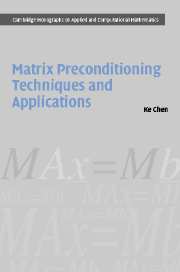Book contents
- Frontmatter
- Contents
- Preface
- Nomenclature
- 1 Introduction
- 2 Direct methods
- 3 Iterative methods
- 4 Matrix splitting preconditioners [T1]: direct approximation of An×n
- 5 Approximate inverse preconditioners [T2]: direct approximation of An×n−1
- 6 Multilevel methods and preconditioners [T3]: coarse grid approximation
- 7 Multilevel recursive Schur complements preconditioners [T4]
- 8 Sparse wavelet preconditioners [T5]: approximation of Ãn×n and Ãn×n−1
- 9 Wavelet Schur preconditioners [T6]
- 10 Implicit wavelet preconditioners [T7]
- 11 Application I: acoustic scattering modelling
- 12 Application II: coupled matrix problems
- 13 Application III: image restoration and inverse problems
- 14 Application IV: voltage stability in electrical power systems
- 15 Parallel computing by examples
- Appendix A a brief guide to linear algebra
- Appendix B the Harwell–Boeing (HB) data format
- Appendix C a brief guide to MATLAB®
- Appendix D list of supplied M-files and programs
- Appendix E list of selected scientific resources on Internet
- References
- Author Index
- Subject Index
- Plate section
- Frontmatter
- Contents
- Preface
- Nomenclature
- 1 Introduction
- 2 Direct methods
- 3 Iterative methods
- 4 Matrix splitting preconditioners [T1]: direct approximation of An×n
- 5 Approximate inverse preconditioners [T2]: direct approximation of An×n−1
- 6 Multilevel methods and preconditioners [T3]: coarse grid approximation
- 7 Multilevel recursive Schur complements preconditioners [T4]
- 8 Sparse wavelet preconditioners [T5]: approximation of Ãn×n and Ãn×n−1
- 9 Wavelet Schur preconditioners [T6]
- 10 Implicit wavelet preconditioners [T7]
- 11 Application I: acoustic scattering modelling
- 12 Application II: coupled matrix problems
- 13 Application III: image restoration and inverse problems
- 14 Application IV: voltage stability in electrical power systems
- 15 Parallel computing by examples
- Appendix A a brief guide to linear algebra
- Appendix B the Harwell–Boeing (HB) data format
- Appendix C a brief guide to MATLAB®
- Appendix D list of supplied M-files and programs
- Appendix E list of selected scientific resources on Internet
- References
- Author Index
- Subject Index
- Plate section
Summary
The experiences of Fox, Huskey, and Wilkinson [from solving systems of orders up to 20] prompted Turing to write a remarkable paper [in 1948] … In this paper, Turing made several important contributions … He used the word “preconditioning” to mean improving the condition of a system of linear equations (a term that did not come into popular use until 1970s).
Nicholas J. Higham. Accuracy and Stability of Numerical Algorithms. SIAM Publications (1996)Matrix computing arises in the solution of almost all linear and nonlinear systems of equations. As the computer power upsurges and high resolution simulations are attempted, a method can reach its applicability limits quickly and hence there is a constant demand for new and fast matrix solvers. Preconditioning is the key to a successful iterative solver. It is the intention of this book to present a comprehensive exposition of the many useful preconditioning techniques.
Preconditioning equations mainly serve for an iterative method and are often solved by a direct solver (occasionally by another iterative solver). Therefore it is inevitable to address direct solution techniques for both sparse and dense matrices. While fast solvers are frequently associated with iterative solvers, for special problems, a direct solver can be competitive. Moreover, there are situations where preconditioning is also needed for a direct solution method. This clearly demonstrates the close relationship between a direct and an iterative method.
- Type
- Chapter
- Information
- Matrix Preconditioning Techniques and Applications , pp. xiii - xxPublisher: Cambridge University PressPrint publication year: 2005

